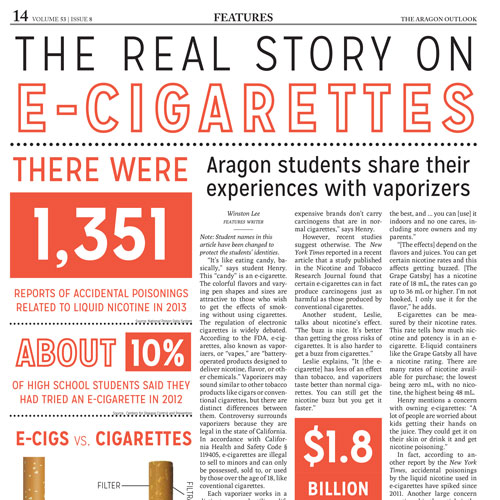
Note: Student names in this article have been changed to protect the students’ identities.
“It’s like eating candy, basically,” says student Henry. This “candy” is an e-cigarette. The colorful flavors and varying pen shapes and sizes are attractive to those who wish to get the effects of smoking without using cigarettes. The regulation of electronic cigarettes is widely debated. According to the FDA, e-cigarettes, also known as vaporizers, or “vapes,” are “battery-operated products designed to deliver nicotine, flavor, or other chemicals.” Vaporizers may sound similar to other tobacco products like cigars or conventional cigarettes, but there are distinct differences between them. Controversy surrounds vaporizers because they are legal in the state of California. In accordance with California Health and Safety Code § 119405, e-cigarettes are illegal to sell to minors and can only be possessed, sold to, or used by those over the age of 18, like coventional cigarettes.
Each vaporizer works in a distinct way and utilizes different techniques to produce vapors. Each is built with an atomizer, a battery, and a cartridge. The atomizer heats the liquid in the cartridge into vapor; the atomizer contains an electrical wire that heats the e-liquid—the flavored juice that gives the e-cigarette its taste. The e-cigarette is powered by a rechargeable battery, which can be charged via USB port.
An e-cigarette can also contain a cartomizer instead of an atomizer. A cartomizer uses polyfill to absorb the vapor and allows for greater e-liquid capacity and lower cost.
The appearance of vaporizers varies. There are “mods” available for vaporizer pens—devices that can be added to vaporizers to increase battery performance or combine a battery and an atomizer.
Henry uses a red vaporizer that resembles a pen. He shows another canister that is labeled “Grape Gatsby.” The canister is neon purple and reads, “18 mL.”
“[They are] healthier. The expensive brands don’t carry carcinogens that are in normal cigarettes,” says Henry.
However, recent studies suggest otherwise. The New York Times reported in a recent article that a study published in the Nicotine and Tobacco Research Journal found that certain e-cigarettes can in fact produce carcinogens just as harmful as those produced by conventional cigarettes.
Another student, Leslie, talks about nicotine’s effect. “The buzz is nice. It’s better than getting the gross risks of cigarettes. It is also harder to get a buzz from cigarettes.”
Leslie explains, “It [the e-cigarette] has less of an effect than tobacco, and vaporizers taste better than normal cigarettes. You can still get the nicotine buzz but you get it faster.”
One of the largest controversies surrounding the use of e-cigarettes is whether they help people quit smoking or whether they lead people to begin smoking conventional cigarettes. Dr. Michael Sieger, a profressor at Boston University, was quoted in a New York Times article arguing that e-cigarettes are a plausible solution to putting an end to smoking in the United States. However, in the same article, Stanton A. Glantz, a professor at UCSF, believes the exact opposite, and that e-cigarettes promote smoking and will become a gateway to conventional smoking. However, one thing experts agree on is that there is limited data to have a truly accurate conclusion on the risks or benefits of e-cigarettes.
Henry compares vaporizers with cigarettes and marijuana, saying, “Vaporizers taste the best, and … you can [use] it indoors and no one cares, including store owners and my parents.”
“[The effects] depend on the flavors and juices. You can get certain nicotine rates and this affects getting buzzed. [The Grape Gatsby] has a nicotine rate of 18 mL, the rates can go up to 36 mL or higher. I’m not hooked, I only use it for the flavor,” he adds.
E-cigarettes can be measured by their nicotine rates. This rate tells how much nicotine and potency is in an e-cigarette. E-liquid containers like the Grape Gatsby all have a nicotine rating. There are many rates of nicotine available for purchase; the lowest being zero mL, with no nicotine, the highest being 48 mL.
Henry mentions a concern with owning e-cigarettes: “A lot of people are worried about kids getting their hands on the juice. They could get it on their skin or drink it and get nicotine poisoning.”
In fact, according to another report by the New York Times, accidental poisonings by the liquid nicotine used in e-cigarettes have spiked since 2011. Another large concern mentioned in the article is the danger the liquid nicotine poses to young children.
In an interview with the New York Times, “Lee Cantrell, director of the San Diego division of the California Poison Control System and a professor of pharmacy at UCSF said, “It’s not a matter of if a child will be seriously poisoned or killed … It’s a matter of when.”
Leslie comments, “They are much more popular among younger people. It’s a trendy thing to do.”
A common concern is that “vaping” is as dangerous as smoking conventional cigarettes, but Darren feels frustration by the lack of studies proving “vaping” is dangerous. “If a well-credited source would publish a study proving that vaporizers are bad then I would stop immediately.”
Additional reporting by Anders Zhou.




